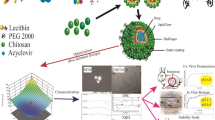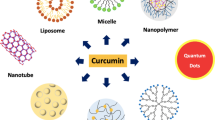Abstract
Exploration of novel bioactive molecules or potentiation of the existing bioactive molecules is necessary to reduce the burden of the infectious diseases for the better human health. Curcumin is a promising molecule with huge therapeutic potential. Despite high bioactivity, its therapeutic suitability is shadowed by poor bioavailability, limited aqueous solubility, and short shelf life. Nanotechnology has generated new avenues to overcome these challenges. In the current study polymer assisted nanoliposomes, PEGylated Curcumin nanoliposomes with good loading efficiency were prepared. These particles have shown 1000 fold enhanced curcumin hydrophilicity and tenfold higher stability. In vitro release kinetic indicates two fold higher curcumin release in the simulated gastric and intestinal environment. Various bioactivity assays have confirmed enhanced bioactivity of nanocurcmin in comparison of the native curcumin. PEGylated Curcumin nanoliposomes could be employed for treating various diseases.


Similar content being viewed by others
References
López-Lázaro M (2008) Anticancer and carcinogenic properties of curcumin: considerations for its clinical development as a cancer chemopreventive and chemotherapeutic agent. Mol Nutr Food Res 52:S103–S127. https://doi.org/10.1002/mnfr.200700238
Anand P, Kunnumakkara AB, Newman RA, Aggarwal BB (2007) Bioavailability of curcumin: problems and promises. Mol Pharm 4:807–818. https://doi.org/10.1021/mp700113r
Wang Y, Lu Z, Wu H, Lv F (2009) Study on the antibiotic activity of microcapsule curcumin against foodborne pathogens. Int J Food Microbiol 136:71–74. https://doi.org/10.1016/j.ijfoodmicro.2009.09.001
Chauhan NS, Nain S, Sharma R (2017) Identification of arsenic resistance genes from marine sediment metagenome. Indian J Microbiol 57:299–306. https://doi.org/10.1007/s12088-017-0658-0
Bisht S, Feldmann G, Soni S, Ravi R, Karikar C, Maitra A, Maitra A (2007) Polymeric nanoparticle-encapsulated curcumin (“nanocurcumin”): a novel strategy for human cancer therapy. J Nanobiotechnol 5:3. https://doi.org/10.1186/1477-3155-5-3
Farnia P, Mollaei S, Bahrami A, Ghassempour A, Velayati AA, Ghanavi J (2016) Improvement of curcumin solubility by polyethylene glycol/chitosan-gelatin nanoparticles (CUR-PEG/CS-G-nps). Biomed Res 27:659–665
Ozcelik B, Ho KKK, Glattauer V, Willcox M, Kumar N, Thissen H (2017) Poly(ethylene glycol)-based coatings combining low-biofouling and quorum-sensing inhibiting properties to reduce bacterial colonization. ACS Biomater Sci Eng 3:78–87. https://doi.org/10.1021/acsbiomaterials.6b00579
Anand P, Nair HB, Sung B, Kunnumakkara AB, Yadav VR, Tekmal RR, Aggarwal BB (2010) Design of curcumin-loaded PLGA nanoparticles formulation with enhanced cellular uptake, and increased bioactivity in vitro and superior bioavailability in vivo. Biochem Pharmacol 79:330–338. https://doi.org/10.1016/j.bcp.2009.09.003
Kim CY, Bordenave N, Ferruzzi MG, Safavy A, Kim KH (2011) Modification of curcumin with polyethylene glycol enhances the delivery of curcumin in preadipocytes and its antiadipogenic property. J Agric Food Chem 59:1012–1019. https://doi.org/10.1021/jf103873k
Cheng KK, Yeung CF, Ho SW, Chow SF, Chow AHL, Baum L (2013) Highly stabilized curcumin nanoparticles tested in an in vitro blood–brain barrier model and in Alzheimer’s disease Tg2576 mice. AAPS J 15:324–336. https://doi.org/10.1208/s12248-012-9444-4
Li L, Ahmed B, Mehta K, Kurzrock R (2007) Liposomal curcumin with and without oxaliplatin: effects on cell growth, apoptosis, and angiogenesis in colorectal cancer. Mol Cancer Ther 6:1276–1282. https://doi.org/10.1158/1535-7163.MCT-06-0556
Dadgar N, Esfahani MKM, Torabi S, Alavi SE, Akbarzadeh A (2014) Effects of nanoliposomal and pegylated nanoliposomal artemisinin in treatment of breast cancer. Ind J Clin Biochem 29:501–504. https://doi.org/10.1007/s12291-013-0389-x
Hwang H, Jeong H-S, Oh P-S, Kim M, Lee TK, Kwon J, Kim HS, Lim ST, Sohn MH, Jeong HJ et al (2016) PEGylated nanoliposomes encapsulating angiogenic peptides improve perfusion defects: radionuclide imaging-based study. Nucl Med Biol 43:552–558. https://doi.org/10.1016/j.nucmedbio.2016.05.010
Ahmed V, Kumar J, Kumar M, Chauhan MB, Vij M, Ganguli M, Chauhan NS (2013) Synthesis, characterization of penicillin G capped silver nanoconjugates to combat β-lactamase resistance in infectious microorganism. J Biotechnol 163:419–424. https://doi.org/10.1016/j.jbiotec.2012.12.002
Ahmed V, Kumar J, Kumar M, Chauhan MB, Dahiya P, Chauhan NS (2015) Functionalised iron nanoparticle–penicillin G conjugates: a novel strategy to combat the rapid emergence of β-lactamase resistance among infectious micro-organism. J Exp Nanosci 10:718–728. https://doi.org/10.1080/17458080.2014.881570
Bhawana Basniwal RK, Buttar HS, Jain VK, Jain N (2011) Curcumin nanoparticles: preparation, characterization, and antimicrobial study. J Agric Food Chem 59:2056–2061. https://doi.org/10.1021/jf104402t
Packiavathy IASV, Agilandeswari P, Musthafa KS, Pandian K, Ravi AV (2012) Antibiofilm and quorum sensing inhibitory potential of Cuminum cyminum and its secondary metabolite methyl eugenol against gram negative bacterial pathogens. Food Res Int 45:85–92. https://doi.org/10.1016/j.foodres.2011.10.022
Ak T, Gülçin İ (2008) Antioxidant and radical scavenging properties of curcumin. Chem Biol Interact 174:27–37. https://doi.org/10.1016/j.cbi.2008.05.003
Otari SV, Patel SKS, Kim SY, Haw JR, Kalia VC, Kim IW, Lee JK (2019) Copper ferrite magnetic nanoparticles for the immobilization of enzyme. Indian J Microbiol 59:105–108. https://doi.org/10.1007/s12088-018-0768-3
Patel SKS, Jeon MS, Gupta RK, Jeon Y, Kalia VC, Kim SC, Cho BK, Kim DR, Lee JK (2019) Hierarchical macroporous particles for efficient whole-cell immobilization: application in bioconversion of greenhouse gases to methanol. ACS Appl Mater Interfaces. https://doi.org/10.1021/acsami.9b03420
Ahmed V, Kumar M, Kumar J, Chauhan MB, Chauhan NS (2014) Nanogold/polyaniline/penicillin G nanoconjugates: a novel nanomedicine. Int J Polym Mater Polym Biomater 63:86–91. https://doi.org/10.1080/00914037.2013.769252
Tao N (2019) Challenges and promises of metal oxide nanosensors. ACS Sens 4:780. https://doi.org/10.1021/acssensors.9b00622
Chen X, Zou L-Q, Niu J, Liu W, Peng SF, Liu CM (2015) the stability, sustained release and cellular antioxidant activity of curcumin nanoliposomes. Molecules 20:14293–14311. https://doi.org/10.3390/molecules200814293
Yatuv R, Robinson M, Dayan-Tarshish I, Baru M (2010) The use of PEGylated liposomes in the development of drug delivery applications for the treatment of hemophilia. Int J Nanomedicine 5:581–591. https://doi.org/10.2147/IJN.S8603
Shin GH, Chung SK, Kim JT, Joung HJ, Park HJ (2013) Preparation of chitosan-coated nanoliposomes for improving the mucoadhesive property of curcumin using the ethanol injection method. J Agric Food Chem 61:11119–11126. https://doi.org/10.1021/jf4035404
Ha PT, Le MH, Hoang TMN, Le TTH, Duong TQ, Tran THH, Tran DL, Nguyen XP (2012) Preparation and anti-cancer activity of polymer-encapsulated curcumin nanoparticles. Adv Nat Sci: Nanosci Nanotechnol 3:035002. https://doi.org/10.1088/2043-6262/3/3/035002
Dhule SS, Penfornis P, He J, Harris MR, Terry T, John V, Pochampally R (2014) The combined effect of encapsulating curcumin and C6 ceramide in liposomal nanoparticles against osteosarcoma. Mol Pharm 11:417–427. https://doi.org/10.1021/mp400366r
Nguyen TTH, Si J, Kang C, Chung B, Chung D, Kim D (2017) Facile preparation of water soluble curcuminoids extracted from turmeric (Curcuma longa L.) powder by using steviol glucosides. Food Chem 214:366–373. https://doi.org/10.1016/j.foodchem.2016.07.102
Geng S, Yang B, Wang G, Qin G, Wada S, Wang JY (2014) Two cholesterol derivative-based PEGylated liposomes as drug delivery system, study on pharmacokinetics and drug delivery to retina. Nanotechnology 25:275103. https://doi.org/10.1088/0957-4484/25/27/275103
Yen FL, Wu T-H, Tzeng CW, Lin LT, Lin CC (2010) Curcumin nanoparticles improve the physicochemical properties of curcumin and effectively enhance its antioxidant and antihepatoma activities. J Agric Food Chem 58:7376–7382. https://doi.org/10.1021/jf100135h
Cabral H, Matsumoto Y, Mizuno K, Chen Q, Murakami M, Kimura M, Terada Y, Kano MR, Miyazono K, Uesaka M, Nishiyama N, Kataoka K (2011) Accumulation of sub-100 nm polymeric micelles in poorly permeable tumours depends on size. Nat Nanotech 6:815–823. https://doi.org/10.1038/nnano.2011.166
Kalia VC (2013) Quorum sensing inhibitors: an overview. Biotechnol Adv 31:224–245. https://doi.org/10.1016/j.biotechadv.2012.10.004
Kalia VC (2014) Microbes, antimicrobials and resistance: the battle goes on. Indian J Microbiol 54:1–2. https://doi.org/10.1007/s12088-013-0443-7
Kalia VC (2017) The dawn of the era of bioactive compounds. In: Kalia VC, Saini AK (eds) Metabolic engineering for bioactive compounds. Springer, Singapore, pp 3–10. https://doi.org/10.1007/978-981-10-5511-9_1
Kalia VC, Patel SKS, Kang YC, Lee JK (2019) Quorum sensing inhibitors as antipathogens: biotechnological applications. Biotechnol Adv 37:68–90. https://doi.org/10.1016/j.bioetchadv.2018.11.006
Kalia VC, Prakash J, Koul S, Ray S (2017) Simple and rapid method for detecting biofilm forming bacteria. Indian J Microbiol 57:109–111. https://doi.org/10.1007/s12088-016-0616-2
Kalia VC, Purohit HJ (2011) Quenching the quorum sensing system: potential antibacterial drug targets. Crit Rev Microbiol 37:121–140. https://doi.org/10.3109/1040841X.2010.532479
Koul S, Kalia VC (2017) Multiplicity of quorum quenching enzymes: a potential mechanism to limit quorum sensing bacterial population. Indian J Microbiol 57:100–108. https://doi.org/10.1007/s12088-016-0633-1
Chavanpatil MD, Khdair A, Patil Y, Handa H, Mao G, Panyam J (2007) Polymer-surfactant nanoparticles for sustained release of water soluble drugs. J Pharm Sci 96:3379–3389. https://doi.org/10.1002/jps.20961
Neelofar K, Shreaz S, Rimple B, Muralidhar S, Nikhat M, Khan LA (2011) Curcumin as a promising anticandidal of clinical interest. Can J Microbiol 57:204–210. https://doi.org/10.1139/W10-117
Jovanovic SV, Steenken S, Boone CW, Simic MG (1999) H-atom transfer is a preferred antioxidant mechanism of curcumin. J Am Chem Soc 121:9677–9681. https://doi.org/10.1021/ja991446m
Acknowledgements
Funding for this work was obtained from the DBT sponsored research Project BT/PR10801/MED/29/826/2014. Anuj Mittal would like to thank Council of Scientific and Industrial Research (CSIR) for fellowships.
Author information
Authors and Affiliations
Corresponding author
Ethics declarations
Conflict of interest
The author declares that they have no conflict of interest.
Additional information
Publisher's Note
Springer Nature remains neutral with regard to jurisdictional claims in published maps and institutional affiliations.
Rights and permissions
About this article
Cite this article
Mittal, A., Kumar, N. & Chauhan, N.S. Curcumin Encapsulated PEGylated Nanoliposomes: A Potential Anti-Infective Therapeutic Agent. Indian J Microbiol 59, 336–343 (2019). https://doi.org/10.1007/s12088-019-00811-3
Received:
Accepted:
Published:
Issue Date:
DOI: https://doi.org/10.1007/s12088-019-00811-3




